If a Tire Goes Flat
Changing a Flat Tire
If a tire goes flat while driving, grasp the steering wheel firmly, and brake gradually to reduce speed. Then, stop in a safe place. Replace the flat tire with a compact spare tire. Go to a dealer as soon as possible to have the full-size tire repaired or replaced.
1. Park the vehicle on firm, level, and non-slippery surface and apply the
parking
brake.
2. Move the shift lever to  .
.
3. Turn on the hazard warning lights and turn the ignition switch to LOCK
 .
.
Periodically check the tire pressure of the compact spare. It should be set to the specified pressure.
Specified Pressure: 60 psi (420 kPa, 4.2 kgf/cm2) When driving with the compact spare tire, keep the vehicle speed under 50 mph (80 km/h). Replace with a full-size tire as soon as possible.
The compact spare tire and wheel in your vehicle are specifically for this model.
Do not use them with another vehicle.
Do not use another type of compact spare tire or wheel with your vehicle.
Do not mount tire chains on a compact spare tire.
If a chain-mounted front tire goes flat, remove one of the full-size rear tires and replace it with the compact spare tire. Remove the flat front tire and replace it with the full-size tire that was removed from the rear.
Mount the tire chains on the front tire.
Do not use a puncture-repairing agent on a flat tire, as it can damage the tire pressure sensor.
■Getting Ready to Replace the Flat Tire

1. Push the rear edge of the handle on the front cargo floor lid and open the lid.

2. Remove the hook from the back of the cargo floor lid.
Pull the hook to the hole on the side panel.
3. Take out the removable box.

4. Take the jack, extension bar, and wheel nut wrench out of the tool case.
NOTICE
Do not use the jack if it doesn’t work properly. Call your dealer or a professional towing service.

5. Remove the cover on the cargo area lining to access the shaft for the spare tire hoist.
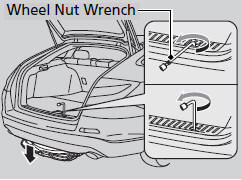
6. Attach the short end of the wheel nut wrench to the spare tire holder shaft.
Turn the wrench to the left to loosen the shaft.
7. Attach the longer section of the wrench to the shaft, and turn it until you can see the spare tire.
- Do not turn the wrench any further once you feel resistance.
8. Lift up the spare tire holder, then slide the
hook to lift down the holder.
9. Remove the spare tire from the holder.
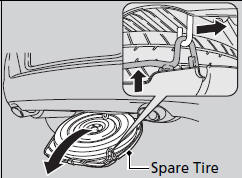
NOTICE
The wheel nut wrench supplied with your vehicle is specially adapted to fit the holder shaft. Do not use any other tool.
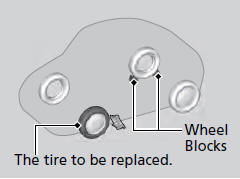
10. Place a wheel block or rock in front and rear of the wheel diagonal to the flat tire.
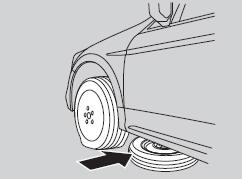
10. Place a wheel block or rock in front and rear of the wheel diagonal to the flat tire.
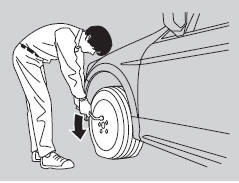
12. Loosen each wheel nut about one turn using the wheel nut wrench.
■How to Set Up the Jack
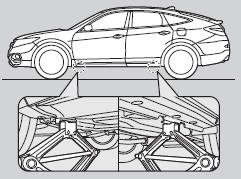
1. Place the jack under the jacking point closest to the tire to be changed.
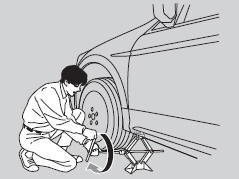
2. Turn the end bracket (as shown in the
image) clockwise until the top of the jack
contacts the jacking point.
- Make sure that the jacking point tab is
resting in the jack notch.
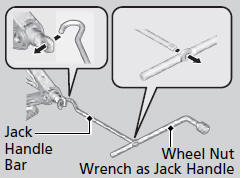
3. Raise the vehicle, using the jack handle bar and the jack handle, until the tire is off the ground.
WARNING
The vehicle can easily roll off the jack, seriously injuring anyone underneath.
Follow the directions for changing a tire exactly, and never get under the vehicle when it is supported only by the jack.
Do not use the jack with people or luggage in the vehicle.
Use the jack provided in your vehicle.
Other jacks may not support the weight (“load”) or their shape may not match.
The following instructions must be followed to use the jack safely.
• Do not use while the engine is running.
• Use only where the ground is firm and level.
• Use only at the jacking points.
• Do not get in the vehicle while using the jack.
• Do not put anything on top of or underneath the
jack.
■Replacing the Flat Tire
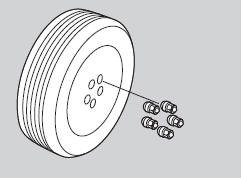
1. Remove the wheel nuts and flat tire.
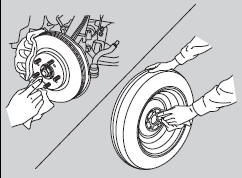
2. Wipe the mounting surfaces of the wheel
with a clean cloth.
3. Mount the compact spare tire.
4. Screw the wheel nuts until they touch the
lips around the mounting holes, and stop
rotating.
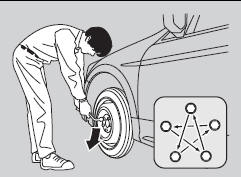
5. Lower the vehicle and remove the jack.
Tighten the wheel nuts in the order indicated in the image. Go around, tightening the nuts, two to three times in this order.
Wheel nut torque:
80 lbf∙ft (108 N∙m, 11 kgf∙m)
Do not over tighten the wheel nuts by applying extra torque using your foot or a pipe.
■Storing the Flat Tire
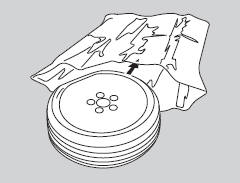
1. Put the Flat tire in the storage bag provided
with your vehicle.
- The storage bag is in the tool case.
2. Knot the top of the storage bag.
3. Securely put the jack and wheel nut wrench
back in the tool case.
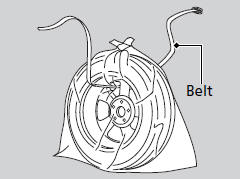
4. Bore through the bag, and pass the holding belt through the hole of the bag and the wheel of the flat tire as shown.
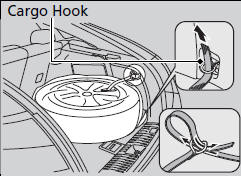
5. Place the flat tire in the cargo area, and
thread the belt through the cargo hook as
shown.
6. Pass the belt through the ring, and tighten
the belt to secure the flat tire in place.
WARNING
Loose items can fly around the interior in a crash and can seriously injure the occupants.
Store the wheel, jack, and tools securely before driving.
Always raise the spare tire holder, even if you are not stowing a tire. If the holder is left down, it will be damaged during driving and need to be replaced.
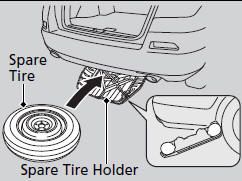
To reinstall the spare tire, place it facing up on the spare tire holder.
NOTICE
If you store the spare tire face down, it can be damaged and needs to be replaced.
■TPMS and the Spare Tire
If you replace a flat tire with the spare tire, the low tire pressure indicator comes on while you are driving. After driving for a few miles (kilometers), the indicator will go off and the TPMS indicator comes on, but this is normal.
If you replace the tire with a specified regular tire, the low tire pressure or TPMS indicator will go off after a few miles (kilometers).
The system cannot monitor the pressure of the spare tire. Manually check the spare tire pressure to be sure that it is correct.
Use TPMS specific wheels. Each is equipped with a tire pressure sensor mounted inside the tire behind the valve stem.
See also:
If the TPMS Indicator Comes On
Reasons for the indicator to come on
- Comes on when there is a problem with the TPMS.
- If the compact spare is installed, the indicator comes on after driving
for a few miles (kilom ...
Cruise Control
Maintains a constant vehicle speed without having to keep your foot on the accelerator.
Use cruise control on freeways or open roads where you can travel at a constant
speed with little acceleration ...
Fuel Economy
Improving Fuel Economy
Fuel economy depends on several conditions, including driving conditions,
your
driving habits, the condition of your vehicle, and loading. Depending on these
and
other co ...






